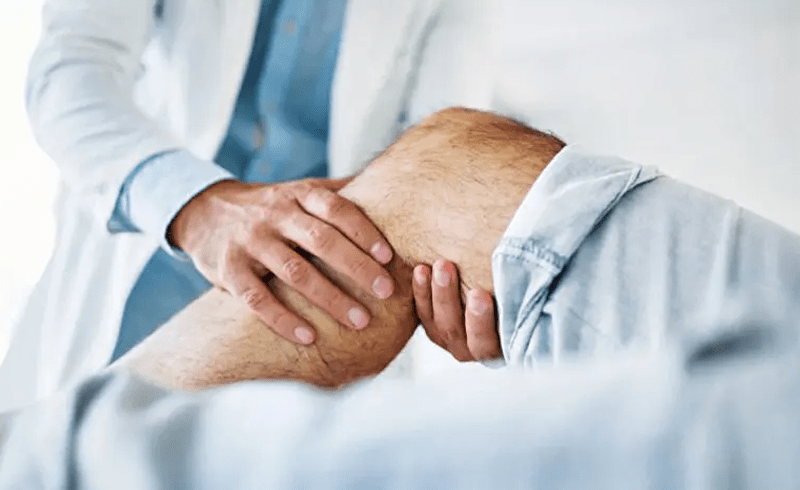It is easy to manage and even reduce unbearable pain in knee-joints at home with physiotherapist on call sessions from Call Doctor UAE. Knee osteoarthritis is the most common type of arthritis, generally associated with ageing. Though young people might also be affected by knee osteoarthritis due to overuse (athletics), obesity (overweight) and hereditary diseases (genetic mutations), it is more likely to surface after the age of 45.
Knee osteoarthritis is a condition which results from wearing of cushioning between the knee joints, also known as cartilage. Due to which, the bones of the knee joint rub more closely against one another in the absence of the shock-absorbing benefits of cartilage. The rubbing of bones results in pain, swelling, stiffness, and reduced mobility. Osteoarthritis symptoms can usually be managed, although the damage to joints can’t be reversed.
How to Identify Knee Osteoarthritis?
Look for following symptoms to identify knee osteoarthritis:
- Pain in your knees when you are active and reduces when you rest
- Swelling around your knee
- Knee area warmer than other body areas
- Stiffness in the knee, especially when you have been sitting for a while or when you wake up in the morning
- Difficulty in use of stairs and a decrease in mobility
- Creaking or cracking sound when the knee moves
If you have spotted any of the above symptoms, immediately get in touch with a medical expert. Early diagnosis can save you from a lot of pain.
Women Are More Prone to Knee Osteoarthritis
It might sound biased but it is a fact. Women aged 55 and older are more likely than men to develop osteoarthritis of the knee. Our physiotherapist on call is ready to come to your home, hotel or office 24/7. Your relief is just a call away! Dial 800 200 400 or book an appointment online.
How Physiotherapist on Call Can Help
In most cases, osteoarthritis is manageable with physiotherapy. Even doctors, after diagnosis, advise physical therapy (PT) to get your strength back and put you on the road to recovery. Physical therapy focuses on the body’s ability to engage in movement. Movement can be anything from getting in and out of chairs to climbing stairs, walking in your neighbourhood, playing a sport or doing recreational activities.
Physical Therapy, also known as rehab, helps ease the muscles around the knee and joint pain. Physical therapy can help to reduce the pain, swelling, and stiffness of knee osteoarthritis, and it can help improve knee joint function. It can also make it easier for you to walk, bend, kneel, squat, and sit. A combination of manual physical therapy and supervised exercise may delay or prevent the need for surgery.
You will need to work with a licensed physical therapist who will use a variety of methods to help boost the strength of your muscles and make it easier for you to move better and reduce pain. You can book physiotherapy on call sessions at your home to manage joint pain (Knee Osteoarthritis) by simply calling 800 200 400.
What you need
The Call Doctor UAE’s physiotherapist will assess the cause of your pain and accordingly decide on the treatment method best suited to your recovery. Things you might need are:
- Stretches and exercises
- Hot and cold treatment
- Ultrasound massage
- Electrical nerve or muscle stimulation
After assessment and charting a course for your treatment and quick recovery the physiotherapy session can continue at your home and for some sessions, after you start moving better, you might need to visit the medical centre.
First Physiotherapy on Call Session at Your Home
You’ll work one on one with our licensed physical therapist to come up with your treatment plan. He’ll discuss ways to rebuild the strength and movement in your leg and knee, so you can feel better and go back to doing the things you love to do without the slightest pain.
At first visit, your therapist will look at your leg and see how well your knee bends, straightens, and moves. He’ll also see if –
- It’s hard for you to maintain balance when standing
- You have pain and swelling in your knee
- Your knee joint makes a creaking sound
- It hurts when you move your lower leg back and forth
- It’s hard to stand on one leg
- You have weak muscles in the front and back of your thigh, which support the knee
To figure out your trouble spots, he may ask you to hop on one leg or take a short walk on a treadmill. He may recommend you use crutches, a walker, or wear special shoes to assist movement and avert falling.
➜ Subsequent Visits
One major reason for Knee Osteoarthritis is increased stress on the knee. In order to reduce the pain, you will start to work on making your leg muscles stronger, which takes some of the stress off your knee and reduces pain. Call Doctor UAE’s physical therapist will give you exercises to do at home and show you how to practice them safely.
➜ Stretches and Exercises
Strength training exercises are a key part of the physical therapy workout. Following are some of the exercise that you will be asked to perform on a regular basis as advised by the therapist
- Hamstring curls
- Single leg dips
- Step-ups
- Straight leg lifts
- Wall Squats
- Balancing exercises
You usually start with just a few reps at a time and then increase reps as you get stronger and feel lesser pain. If you can, you may need to add weights to make your muscles work harder only on the advice of the therapist. Immediately tell your therapist if something hurts. A little discomfort may be felt in the beginning and should not stop you from performing these exercises, but stop if you feel a lot of pain.
Plan to get adequate rest as you could feel stiff or sore after your therapy. Our therapist will advise you on how to get relief from this soreness.
➜ Hot and Cold Treatment
Applying heat to the sore, tensed muscles can be relaxing and relieve stiffness and pain in the joints. Heat also stimulates blood flow and improves circulation, resulting in an increased range of motion and reduced stiffness in painful joints.
When you feel inflammation or a sensation of burning in your painful knee – applying an ice pack or even a packet of frozen vegetables or milk (it is easy to wrap these around knees) can help numb areas affected by joint pain. Cold treatment also helps in reducing swelling which eventually lessens joint pain.
Call Doctor UAE’s physical therapist will advise you whether to use hot or cold treatment to reduce your knee pain. You should never apply heat to your knee that is already hot, red, and swollen, for example, nor should you apply cold to a joint that’s stiff and not moving well. Remember, heat helps muscles relax; cold helps to minimize inflammation and pain.
It’s also important to be careful when using hot and cold therapy to manage arthritis pain, or you might end damaging your skin from exposure to relatively extreme temperatures. Always seek experts help.
➜ Ultrasound Massage
Ultrasound massage therapy is the use of sound waves to treat medical problems, especially musculoskeletal problems like knee osteoarthritis. It has been a popular therapy for decades, its use so widespread that it almost defines physical therapy. To undergo ultrasound massage therapy you will need to visit the medical centre on the advice of our therapist.
➜ Electrical Nerve or Muscle Stimulation
Call Doctor UAE’s physical therapist may also use electricity to help improve your leg muscle strength and knee movement. It’s a method called “TENS,” short for transcutaneous electrical nerve stimulation. He’ll put sticky patches called electrodes on the front of the thigh above your knee. A wire connects each one to the TENS machine. He turns it on, and when he does, tiny electrical signals tingle the nerves in your muscle. This boosts the flow of your blood and helps ease the pain.
How Long Does it Take to Recover?
How long you need to continue the physiotherapy sessions depends on how much pain you feel and how severe is the joint pain condition. The sessions might be several times a week for 6 weeks or longer depending on the advice of our doctor and physiotherapist. Our aim is to provide you with the utmost care and expert services at the comfort of your home. There is no place like home and it has the best stimulating environment to speedy recoveries. Contact us when you need our services at your home. Doctors and nurses on call are available 24×7 @ 800-200-400.




